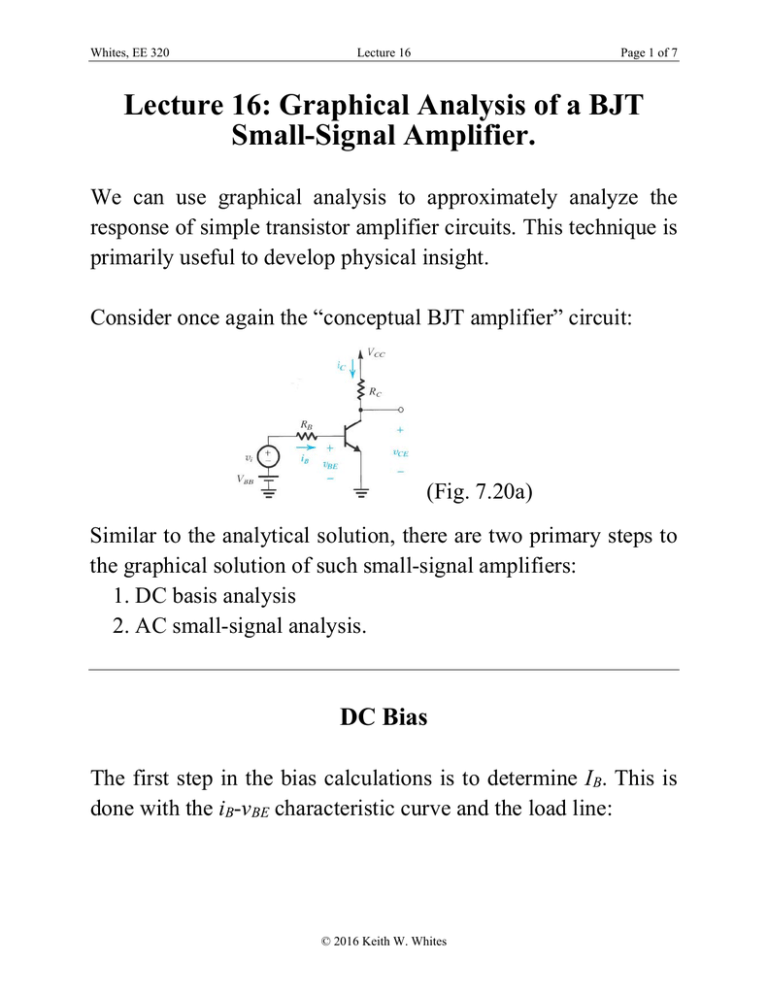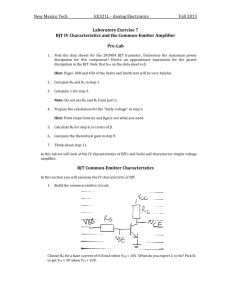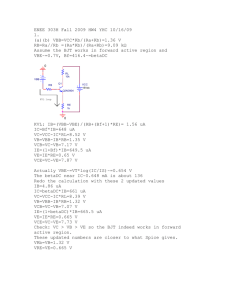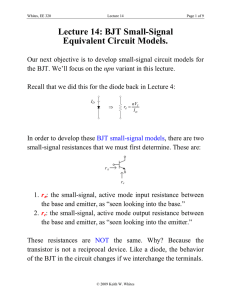Lecture 16: Graphical Analysis of a BJT Small
advertisement

Whites, EE 320 Lecture 16 Page 1 of 7 Lecture 16: Graphical Analysis of a BJT Small-Signal Amplifier. We can use graphical analysis to approximately analyze the response of simple transistor amplifier circuits. This technique is primarily useful to develop physical insight. Consider once again the “conceptual BJT amplifier” circuit: (Fig. 7.20a) Similar to the analytical solution, there are two primary steps to the graphical solution of such small-signal amplifiers: 1. DC basis analysis 2. AC small-signal analysis. DC Bias The first step in the bias calculations is to determine IB. This is done with the iB-vBE characteristic curve and the load line: © 2016 Keith W. Whites Whites, EE 320 Lecture 16 Page 2 of 7 VBB I B RB VBE IB VBE VBB RB RB (Fig. 1) (Sedra and Smith, 5th ed.) Once IB has been determined we can compute IC knowing that I C I B for a BJT in the active mode. With this IC value and the iC-vCE characteristic curve of the transistor, we can determine VCE. We haven’t yet seen the iC-vCE characteristic curve of the BJT. This can be measured using the circuit in Fig. 2 below. vBE is fixed at some value, then vCE is swept while measuring iC. The results are shown below for different values of vBE. (Fig. 2) (Sedra and Smith, 5th ed.) Whites, EE 320 Lecture 16 Page 3 of 7 (Curve tracers are pieces of equipment that will measure and display families of iC-vCE characteristic curves for transistors.) When vCE is very small, iC is nearly zero. This is the cutoff mode of the BJT. As vCE increases but is still small, the CBJ is forward biased and the BJT is in the saturation mode. When vCE becomes large enough, the CBJ becomes reversed biased and the BJT enters the active mode. The slopes of the lines in Fig. 2 in the active mode are quite exaggerated in this figure. So, back to the graphical solution. With the I C I B value from Fig. 1, the iC-vCE characteristic curve of the transistor from Fig. 2, and the load line representing the effects of the collector circuit, we can determine VCE: VCC I C RC VCE IC VCE VCC RC RC (Fig. 3) Whites, EE 320 Lecture 16 Page 4 of 7 (Sedra and Smith, 5th ed.) AC Small-Signal Analysis The first step in the AC small-signal analysis is to determine ib. This is performed using a slightly complicated interaction of the input waveform vi, the subsequent time variation of the load line, and the iB-vBE characteristic curve of the BJT: (Fig. 4) (Sedra and Smith, 5th ed.) From this comes the small-signal quantities vbe and ib. Whites, EE 320 Lecture 16 Page 5 of 7 With ib known and ic ib , then we use these values on the iCvCE characteristic curve to determine vce: (Fig. 5) (Sedra and Smith, 5th ed.) Cutoff and Saturation Notice that there are limits on vCE in which the BJT remains in the active mode: Too large ( VCC ) and the BJT cuts off Too small (few tenths of a volt) and the transistor saturates. Whites, EE 320 Lecture 16 Page 6 of 7 These limits are readily apparent if we reexamine the previous figure of the small-signal variation: (Fig. 6) (Sedra and Smith, 5th ed.) Because of these limits on vCE, it is important to choose the Q point properly to all for the desired swing in the signal voltage (vce). Whites, EE 320 Lecture 16 Page 7 of 7 (Fig. 7) (Sedra and Smith, 5th ed.)



